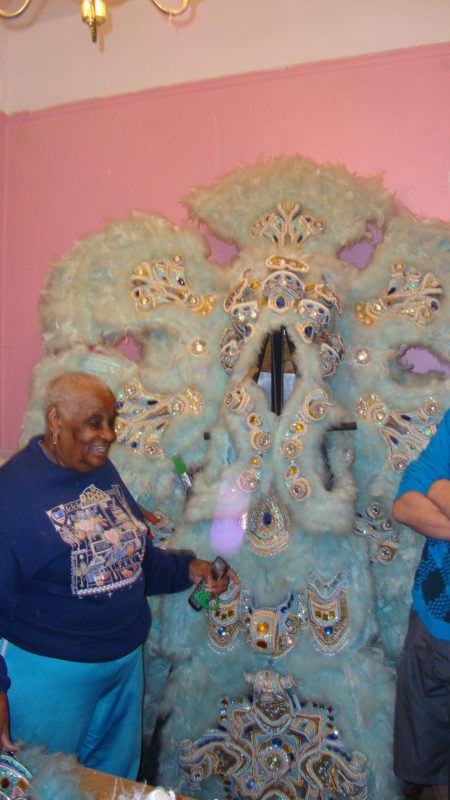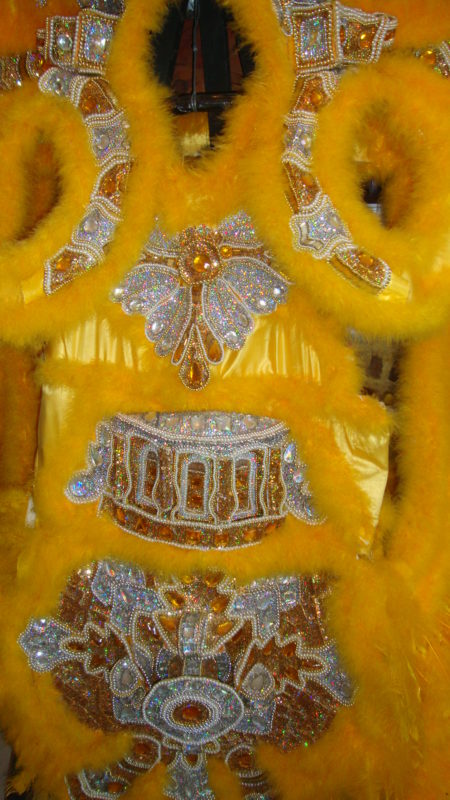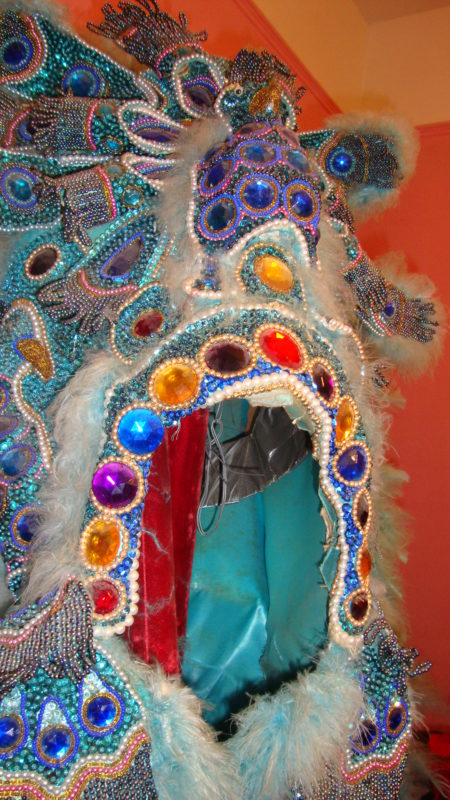The suits worn by the various members of a tribe on Mardi Gras day are nothing short of fantastical moving, dancing works of art! The flowing plumes in a rainbow of colors catching the morning light are a sight that is pure New Orleans, pure delight and excitement. As the tribes meet each other a contest ensues as to which Chief is the “prettiest.” That moment of contact is a culmination of work that begins a year before on the construction of the suit and crown the Chief will wear.
Big Chief Tootie Montana of the Yellow Pocahontas tribe was hailed as “the prettiest” by all who knew him. He masked for 52 years and always with a new suit and crown. In a visit with his widow, Mrs. Joyce Montana, she explained the process of putting a suit together. When asked about how Tootie got his ideas and inspiration Ms. Joyce simply said that it was just what he would come up with from his own imagination. Mr. Montana was a metal lather as an occupation. He worked forming metal to make doorway arches and other three dimensional shapes in buildings and homes. From this knowledge he was able to see suit construction in a three dimensional way. This three-dimensional aspect was new to the Mardi Gras Indian suit construction and a distinguishing characteristic of the suits of the Yellow Pocahontas Tribe.
In the tribes of the Downtown area of New Orleans, their suits feature beaded scenes depicting Native American themes. These scenes are done totally with small seed beads that are individually sewn on the canvas. Thousands of beads are sewn one by one until the picture is complete. These scenes are attached to the suit but are flat. The scene pieces make up a sort of apron at the front of the suit either on the chest area or below the waist. There are also scenes attached as gauntlets around the arms or on the legs.

An intricately crafted headpiece. Photo by Barbara Miller.
The design of suits consists of many parts and pieces. Tootie Montana’s suits and the suits of the Uptown New Orleans tribes feature various designs that lend themselves to have parts of the design that extend beyond the flat plane of a panel. Tootie could take cardboard and form it, much as he did in his work, to become a three-dimensional element on a section of his suit. The smaller sections of each element would then be traced out onto fabric and the process of beading would begin. Each small section would have a trim border applied, and the field would then be filled in with sequins and seed beads applied one at a time until the whole field was covered in brilliance. All of these various pieces would then be applied using a glue gun to the main body of the suit. Like a jeweled jigsaw puzzle the final three dimensional effects would emerge and it would be like no other suit seen on the streets on Mardi Gras morning.

Tootie-Montanna’s flashy chest piece. Photo by Barbara Miller.
The work on the suits starts the day after Mardi Gras for the coming year. This immense amount of work often becomes a family project with everyone picking up needle and thread to help make the vision come alive. Since the suit and crown are pieced together by various elements, the work can be split up and many hands can help with the sewing. Ms. Joyce was working on a section of a suit when we visited at her dining room table. She said that when the time gets closer to Mardi Gras day, every seat around the table will be filled with a friend or family member coming to help finish up a suit. She remarked that if Tootie’s suit was finished early, he would inspect it and find another spot where an element could be added.
Along with the glittering suit and crown, there are plumes applied that give the crown and suit its height and drama. The plumes are the main color element that the rest of the suit coordinates with. A crown can be very heavy with at times 350 plumes attached. The plumes frame the body and head of the masker and make for a formidable impression. The plumes are arranged so that the entire back of the masker is covered making the masker exciting to see both from the front and back of the costume.
The suits that Ms. Montana has stored in a separate section of her home are indeed art treasures. There are Indian suits around New Orleans that are most likely up in attics or other places that are not the best storage conditions for such delicate works of art. There is a crying need for a preservation movement to ensure that these works are preserved. This is a unique cultural element that the city of New Orleans has that must be protected.

A bright, beaded headdress. Photo by Barbara Miller.
Each suit is a reflection of the masker’s imagination and artistic abilities. They are fantastical creations to say the least. They represent countless hours of tedious work. The reward for the work is the thrill of meeting another tribe, having that contact, seeing their suits and having them declare that your suit is the prettiest. It’s all over in one day, but the ideas start to flow for the next year as soon as the suit comes off. What will the colors be? How can the next suit top this year’s suit? Better get to work!
*This piece was originally published on December 5, 2012.
 NOLAbeings
Multimedia artist Claire Bangser created NOLAbeings as a portrait-based story project that marries...
NOLAbeings
Multimedia artist Claire Bangser created NOLAbeings as a portrait-based story project that marries...
 Data corner: Adobe Suite (create a PDF, social media graphic, presentation, edit a photo and video
Data corner is where you go to work with analytics and top tech skills. It takes on everything from PERL and SQL to Canva and Sprout Social.
Data corner: Adobe Suite (create a PDF, social media graphic, presentation, edit a photo and video
Data corner is where you go to work with analytics and top tech skills. It takes on everything from PERL and SQL to Canva and Sprout Social.
